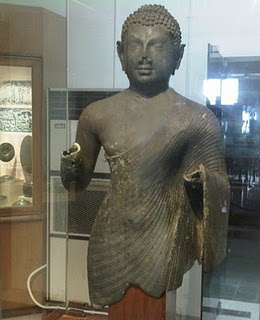SULAWESI BUDDHA, THE

Called the Sulawesi Buddha after the Indonesian island where it was found, this statue is one of the finest pieces of bronze sculpture from ancient Southeast Asia. It was unearthed from a collection of ruins at Sikendung on the west coast of Sulawesi in 1921. The statue is in the Amaravati style of south India (3rd to 5th century CE) and was either imported from there or is a copy made by a local Indonesian sculptor. It was originally standing although it is now broken off at the waist and its right hand was in the gesture of imparting fearlessness (abhaya mudra) although both hands are now missing. The expression on the face is one of serene alertness and the features are sharply defined, especially the hair and the folds of the robes. Having been found at 118 degrees longitude, the Sulawesi Buddha thus provides material evidence of the furthest reaches of the eastern spread of Buddhism in ancient times. The Sulawesi Buddha is now on display in the National Museum in Jakarta. See Westernmost Spread of Buddhism.